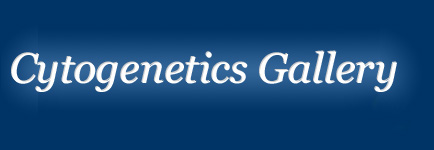 |
|
Cytogenetics |
||
| Introduction | ||
| What is a chromosome? | ||
| Human Karyotypes/Spreads | ||
|
Cytogenetic Abnormalities |
||
| Constitutional | ||
| Aquired | ||
|
Mammal Examples |
||
| Mouse Karyotype | ||
| Mouse Idiogram | ||
|
Methods of chromosome visualization |
||
| Banding Patterns | ||
|
Fluorescence In-Situ Hybridization (FISH) |
||
| FISH Examples | ||
| FISH Cartoon | ||
Banding PatternsChromosomes in metaphase can be identified using certain staining techniques, so called banding.
Cells are cultured and then stopped in metaphase to maximize the number of suitable cells. They are
then spread on a slide, stained with a suitable dye and visualized in the microscope.
Most conventional cytogenetic analyses depend on the karyotyping of banded metaphase chromosomes.
Bright field G-bandsThese G-bands are most commonly used. They take their name from the Giemsa dye, but can be produced with other dyes. In G-bands, the dark regions tend to be heterochromatic, late-replicating and AT rich. The bright regions tend to be euchromatic, early-replicating and GC rich. Bright field R-bandsThese R-bands are approximately the reverse of G-bands (the R stands for "reverse"). The dark regions are euchromatic and the bright regions are heterochromatic. Fluorescent G- and R-bandsThese bands are the photographic negative of the bright field versions. i.e. the reverse of the bright field G-bands and R-bands. Q-bands are like fluorescent G-bands, but certain heterochromatic regions are more brightly stained with Q-banding. |